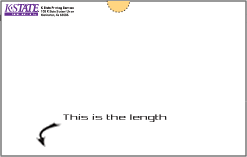- K-State home
- University Printing
- Services
- Mailing Services
- Physical Standards
Physical Standards
Mail Piece Dimensions
Mailing costs and classifications depend on size and adherence to USPS dimensional standards:
Postcards: Must be 3½" x 5" to 4¼" x 6" and at least 0.007" thick for postcard rates. Larger or thicker cards incur letter-rate postage. Nonprofit bulk rates apply for cards up to 6⅛" x 11½".
Letters: Dimensions range from 5" x 3½" to 11½" x 6⅛" and up to ¼" thick. Over 3.5 ounces or outside these dimensions, mail is charged flat rates. Folding documents to letter size can reduce postage costs.
Flats: Exceed 11½" x 6⅛" or ¼" thick but not more than 15" x 12" or ¾" thick. Must be flexible, rectangular, and uniformly thick.
Design Tips:
- Postcards require a blank 4½" x ½" area for barcoding.
- Letter-size mail must be horizontally rectangular to avoid surcharges for nonmachinable pieces.
- Use 60# paper or heavier for mailable folded brochures.
Proper folding and design reduce costs, ensure machinability, and prevent delays.
